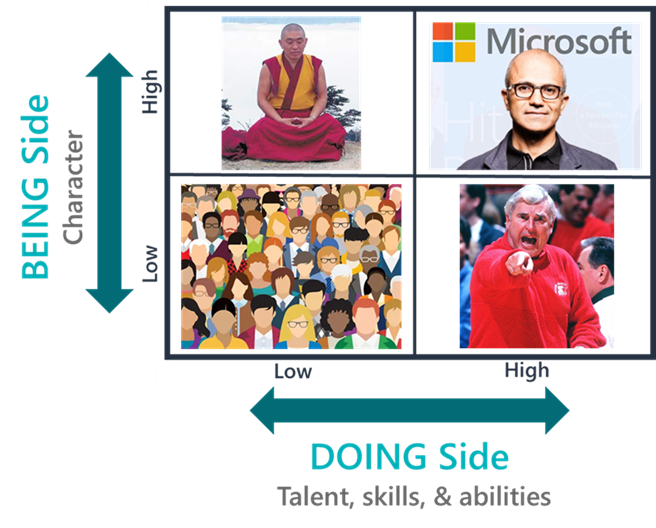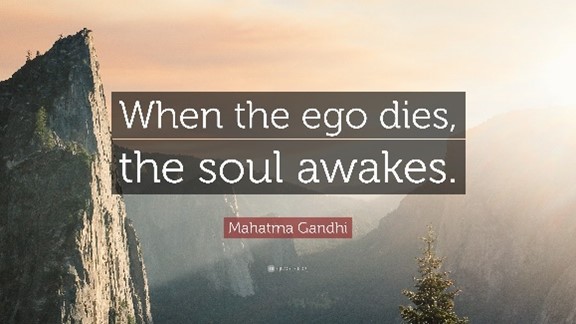What do these people have in common: Bobby Knight, Michael Jackson, Lindsay Lohan, Shia LaBeouf, Naomi Campbell, Bill Clinton, Richard Nixon, Gordon Ramsay, and Tiger Woods?
These are all people that are immensely talented, but have operated in a manner that reveals that they are perceived as having a flawed character.
This similarity exposes an important concept that we would all benefit from understanding: We have two sides to ourselves. We have a DOING side, which represents our level of talent, knowledge, skills, and abilities. We also have a BEING side, which represents the quality of our character and psyche.

Using this framework, let’s explore the following questions:
What Quadrant Contains the Most People?
Most people (general population) operate in the low DOING and low BEING. Most people don’t have talent, knowledge, skills, and abilities that cause them to stand out amongst the general population. Also, research reveals that 64% of people never develop their character during adulthood (BEING side).
Where Do Most Leaders Operate?
Most leaders are put into leadership positions because they stand out on the DOING side. They have demonstrated proficiency as an individual performer, providing them with opportunities to get promoted.
But, research has found that 85% of executives only operate at a moderate level of character (i.e., their BEING side).
Thus, most leaders tend to operate in High DOING and Low to Moderate BEING.
Why is this?
The reality is that 95%+ of all development work people engage in or receive focuses on improving our DOING side. Very little development efforts focus directly on our BEING side.
In fact, when I ask leadership development experts how to best help leaders develop character (i.e., BEING side), they either have vague answers or talk about DOING side development efforts.
Why the BEING Side is So Important
The best leaders excel in the BEING side. If a leader stands out as being great, it is generally not because of their DOING side, it is because of their BEING side.
The more leaders elevate in their BEING side, the:
- Wider their window of tolerance
- More they are focused on “we” instead of “me”
- More they are adaptable (as opposed to rigid)
- Better able they are to effectively navigate change, pressure, uncertainty, and complexity
- More they individualize their leadership efforts
- More they focus on aspects of leadership that lead to long-term success (e.g., culture, trust, psychological safety)
- More they care about and invest in others
- More purpose-focused and values-driven they are
When leaders are low in their BEING Side, they:
- Micromanage
- Operate as firefighters
- Lack vision, strategy, and direction
- Lack emotional intelligence
- Are short-term oriented
- Care more about themselves than those they are leading
In addition to the BEING side affecting how a leader or person operates, I have also learned that if you have two people with the same level of talent and abilities (DOING side), the person with the higher BEING side will get more out of their talent and abilities because they will be more apt to more appropriately and effectively utilize their talents and abilities.
Check In with Yourself
When it comes to your own development, how much emphasis do you place on developing your BEING side?
When it comes to developing people on your team or your organization, how much emphasis do you place on the BEING side?
How to Elevate on Our BEING Side
When we engage in efforts to improve our DOING side, we are engaging in what is called Horizontal Development. This is like downloading an app onto an iPad. It broadens what a person can do.
When we engage in efforts to improve our BEING side, we are engaging in what is called Vertical Development. This is like upgrading the iPad’s operating system. It elevates how effectively the person functions.
Vertical Development efforts are varied, but they all have one thing in common: They are designed to upgrade and refine one’s nervous system so that they operate with higher levels of cognitive and emotional sophistication.
When I work with organizations, I primarily focus on improving mindsets as a way to help upgrade one’s internal operating system.
But, I have also benefited from (1) engaging in coaching and exercises designed to stretch my body’s nervous system, and (2) engaging with a therapist.
Moral of the Story
Whether for your own benefit or for the people you develop: Place greater emphasis on the BEING side.
BECOME better, or help others to BECOME better.
If you would like assistance, support, guidance, or help focusing on the BEING side in your development efforts, let’s connect.










